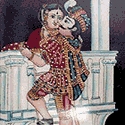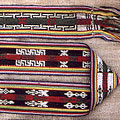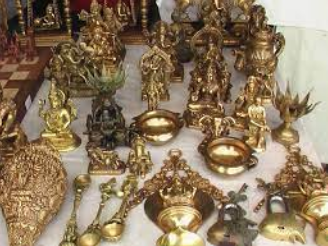The technique of painting on glass in India originated in the second half of the 18th century, chiefly owing to the influence of Chinese artists who lived and worked for the nobility and royalty. Glass paintings, as the name indicates, are paintings done on clear glass. The process requires immense skill and, as a genre, glass painting is extremely difficult for the sequence of steps followed when painting on an opaque surface, is reversed in painting glass.
Although religious themes dominate, court scenes and portraits are also common. Essentially a popular art, the technique of glass painting spread rapidly in western and southern India, though examples of regional styles are also found in Uttar Pradesh, Rajasthan, Bihar, and Bengal. The town of Thanjavur ( Tamil Nadu) became known for the craft of painting on glass and this tradition continues till today. Very often the glass paintings are mistakenly referred to as the Thanjavur sacred icon paintings since these glass paintings tend to repeat the composition of their more expensive counterpart. The glass paintings are decorated with gold leaf, thereby providing devotional images for the puja (worship) room. The colours used are rich and bold and have a feeling of opulence. If the figure painted is that of a deity it is surrounded or housed within a frame. Often the formal frame is created by depicting heavily fringed and tasselled curtains, chandeliers, glass lamps, winged angels, or heavy furniture.
Painting on glass involves a process different from the procedure used when painting on opaque surfaces. The technique requires visual memory since the details, especially the finishing and shading lines, are painted in first and the large areas of colour are filled in afterwards. The picture is mounted with its unpainted side uppermost so that it can be viewed through the glass. The paintings are executed by skilled artists who wield a bold and confident brush. The picture, in tempera, is begun with the brush outlines and finer details being filled in first. Interestingly when the painting is finished these lines appear on the top layer. When areas were left unpainted a gold or silver foil is pasted on to give the effect of gilding. The next stage is when the larger areas are filled in with opaque paints. These areas are generally given a flat finish except when depicting drapery or when used to depict the face and body, in which case shading techniques are used.
Gallery
YOUR VIEWS
PRACTITIONERS: INDIA
Access 70,000+ practitioners in 2500+ crafts across India.
BIBLIOGRAPHY
10,000+ listings on arts, crafts, design, heritage, culture etc.
GLOSSARY
Rich and often unfamiliar vocabulary of crafts and textiles.
SHOP at India InCH
Needs to be written.






